Potřebujeme váš souhlas k využití jednotlivých dat, aby se vám mimo jiné mohly ukazovat informace týkající se vašich zájmů. Souhlas udělíte kliknutím na tlačítko „OK“.
ASTM E2459-05(2011)
Standard Guide for Measurement of In-Duct Sound Pressure Levels from Large Industrial Gas Turbines and Fans
Automaticky přeložený název:
Standardní Příručka pro měření In-tlak v potrubí a hladiny akustického tlaku z velkých průmyslových plynových turbín a ventilátory
NORMA vydána dne 1.4.2011
Informace o normě:
Označení normy: ASTM E2459-05(2011)
Poznámka: NEPLATNÁ
Datum vydání normy: 1.4.2011
Kód zboží: NS-45347
Počet stran: 6
Přibližná hmotnost: 18 g (0.04 liber)
Země: Americká technická norma
Kategorie: Technické normy ASTM
Kategorie - podobné normy:
Hluk působený stroji a zařízeními
Plynové a parní turbiny. Parní stroje
Anotace textu normy ASTM E2459-05(2011) :
Keywords:
field sound pressure level, gas turbine exhaust noise, gas turbine inlet noise, gas turbine noise, high temperature flow noise, in-duct sound, industrial noise, machinery noise, noise in turbulent flow, ICS Number Code 17.140.20 (Noise emitted by machines and equipment), 27.040 (Gas and steam turbines. Steam engines)
Doplňující informace
| Significance and Use | ||||||
|
All noise control features associated with the inlet or exhaust of large industrial fans and gas turbines are, or should be, based upon inlet or exhaust sound power levels in octave bands of frequency. Sound power levels are not directly measurable, however, so they must be calculated indirectly, using estimated or measured duct interior sound pressure levels. Estimated in-duct sound pressure level may be obtained by measuring exterior airborne sound pressure levels and applying a transfer function representing the transmission loss of the duct wall. Significant uncertainties are associated with such a procedure, suggesting the need for this guide. Estimated in-duct sound pressure level may be obtained by measuring exit plane sound pressure levels and applying a transfer function consisting of the insertion loss through the gas path, including the insertion loss of any silencers. Significant uncertainties are associated with such a procedure, suggesting the need for this guide. This guide purports to measure the in-duct sound pressure level directly using type 1 instrumentation per ANSI S1.4 or S1.43. It is limited, however, to the determination of the sound pressure level at the location of the port only and will include the effects of duct acoustical modes, as well as an unknown degree of turbulence and other flow related effects. Methodologies may be devised by the user to minimize such effects. As a rule, the larger the number of test ports used, the better will be the averaged data. Although not prescribed by this guide, cross-channel coherence analysis is also available to the analyst, using ports at different locations along the duct axis, which may yield improvements in data quality. This guide is intended for application to equipment in-situ, to be applied to large fans and gas turbines having inlet or exhaust ducts whose cross sectional areas are approximately four (4) square meters, or more, and are therefore not amenable to laboratory testing. All of the field experience on the part of task group members developing this guide has been on gas turbine ducts having cross sections in excess of ten (10) square meters. This guide has no known temperature limitations. All of the field experience on the part of task group members developing this guide has been on gas turbine ducts having temperatures between ambient and 700°C. |
||||||
| 1. Scope | ||||||
|
1.1 This guide is intended to provide a simple and consistent procedure for the in-situ field measurement of in-duct sound pressure levels in large low pressure industrial air ducts, such as for gas turbines or fans, where considerations such as flow velocity, turbulence or temperature prevent the insertion of sound pressure sensors directly into the flow. This standard guide is intended for both ambient temperature intake air and hot exhaust gas flow in ducts having cross sections of four (4) square meters, or more. 1.2 The described procedure is intended to provide a repeatable and reproducible measure of the in-duct dynamic pressure level at the inlet or exhaust of the gas turbine, or fan. The guide is not intended to quantify the “true” sound pressure level or sound power level. Silencers, as well as Waste Heat Boilers, must be designed using the in-duct sound power level as the basis. Developing the true sound power level based on in-duct measurements of true sound pressure within a complete operating system is complex and procedures are developmental and often proprietary. 1.3 This standard does not purport to address all of the safety concerns, if any, associated with its use. It is the responsibility of the user of this standard to establish appropriate safety and health practices and determine the applicability of regulatory limitations prior to use. Extreme caution is mandatory when working near hot exhaust gas systems and appropriate safety precautions such as the installation of quick acting isolation valves are recommended. |
||||||
| 2. Referenced Documents | ||||||
|
Podobné normy:
Historická
15.6.2012
Historická
1.1.2013
Historická
15.6.2012
Historická
1.6.2013
Historická
1.4.2009
Historická
15.6.2012


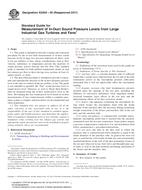
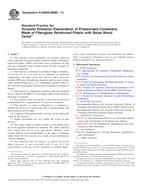 ASTM E1888/E1888M-12..
ASTM E1888/E1888M-12..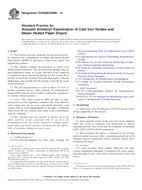 ASTM E2598/E2598M-13..
ASTM E2598/E2598M-13.. ASTM E2863-12
ASTM E2863-12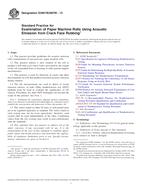 ASTM E2907/E2907M-13..
ASTM E2907/E2907M-13..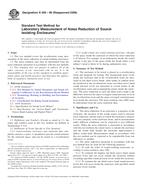 ASTM E596-96(2009)..
ASTM E596-96(2009)..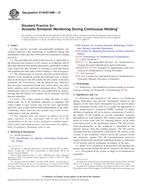 ASTM E749/E749M-12..
ASTM E749/E749M-12..
 Cookies
Cookies
